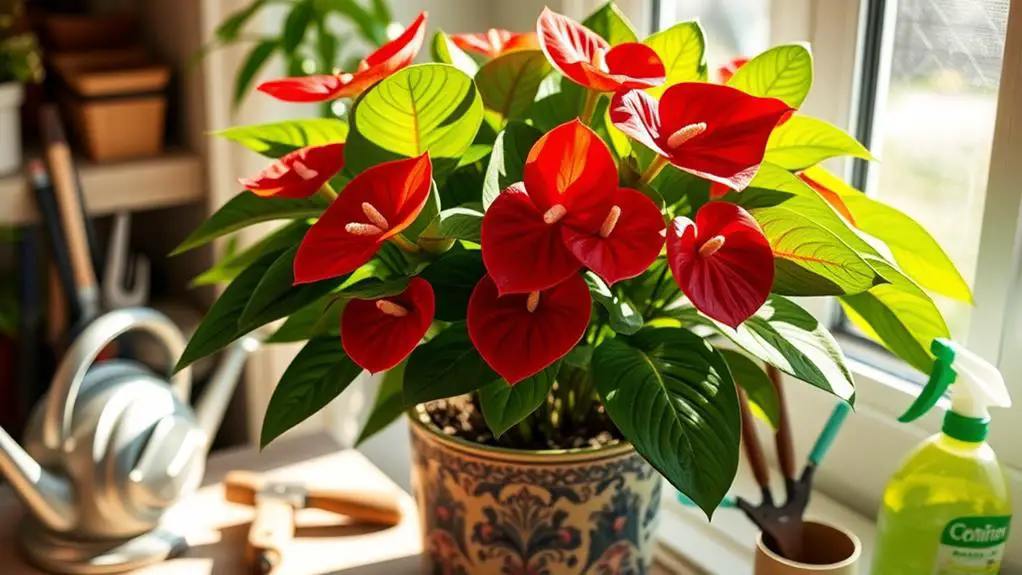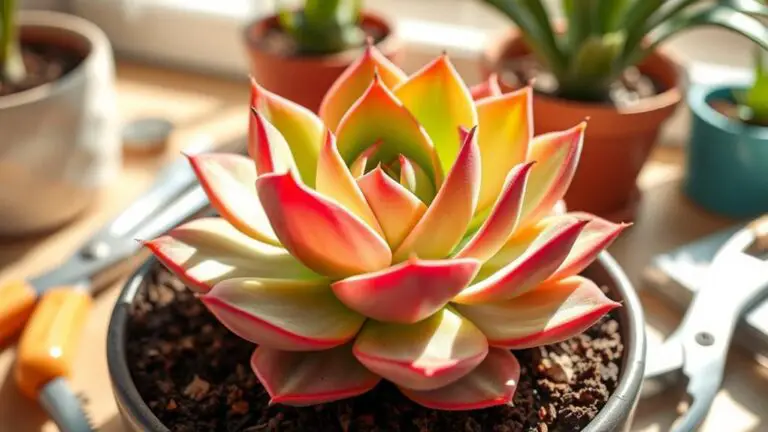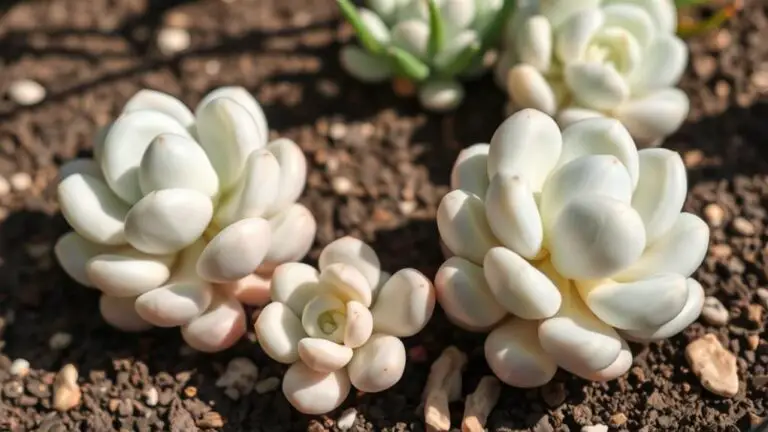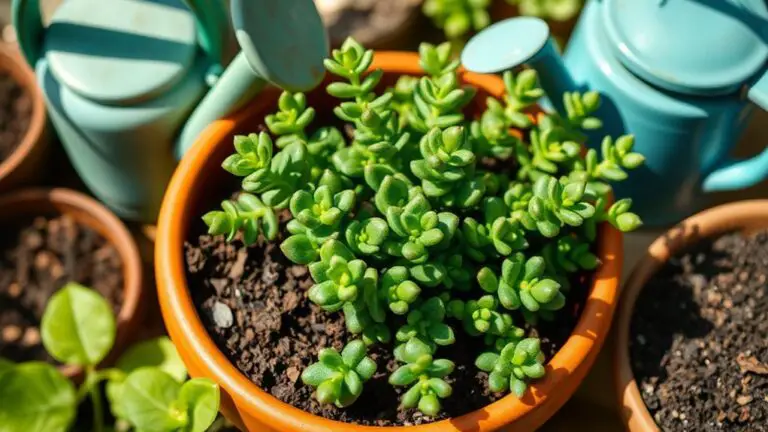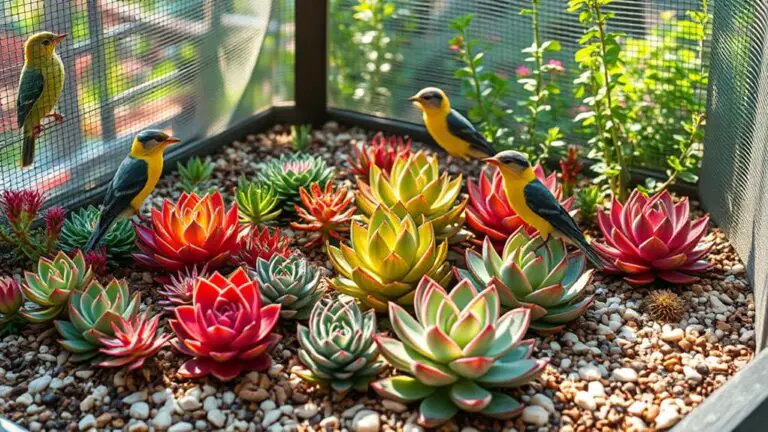7 Essential Steps to Grow and Care for Your Anthurium Plant
Caring for your Anthurium plant might seem challenging, but with the right approach, you'll find it quite manageable. Start by understanding the basics of what your plant needs to thrive. It's important to provide bright, indirect light and avoid direct sunlight to prevent leaf burn. You'll also need to develop an effective watering routine, ensuring the topsoil dries out between waterings. But that's just the beginning. To truly master Anthurium care, you'll need to evaluate soil quality, humidity levels, and more. Let's explore the essential steps in detail.
Understand Anthurium Basics
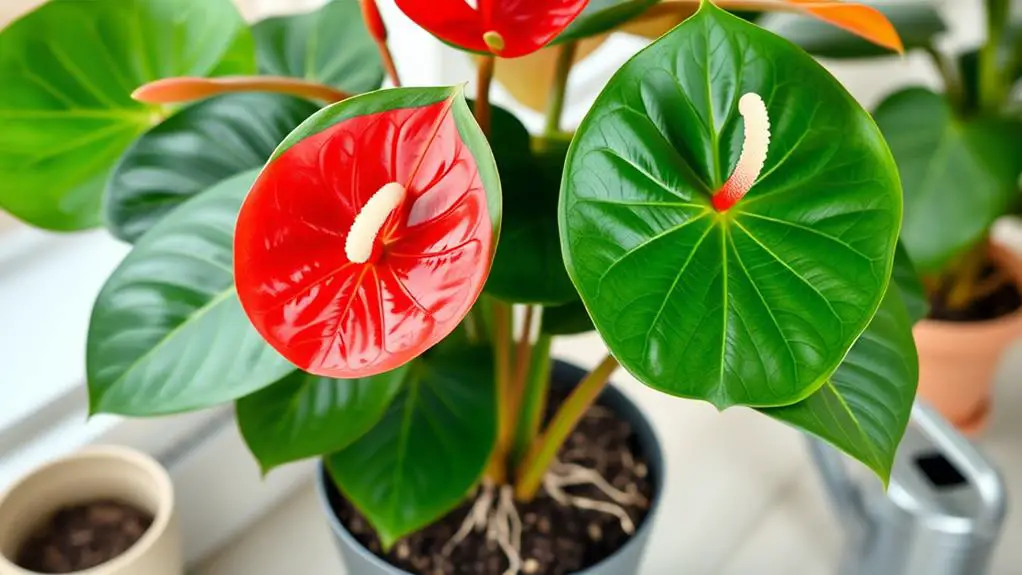
Anthurium andraeanum, often called the tail flower or flamingo flower, is a striking plant with vibrant spathes that can brighten any indoor space.
To thrive, your Anthurium needs bright, indirect light and high humidity levels. Aim for around 80% humidity, which mimics its native tropical environment. Make sure to plant it in well-draining soil to prevent root rot.
Anthuriums are toxic to pets and humans if ingested, so place them out of reach of curious animals and children.
Remember to clean the leaves regularly and let the soil dry slightly between waterings. With these basics, you'll create a welcoming home for your Anthurium, ensuring it stays healthy and vibrant for months.
Provide Ideal Lighting
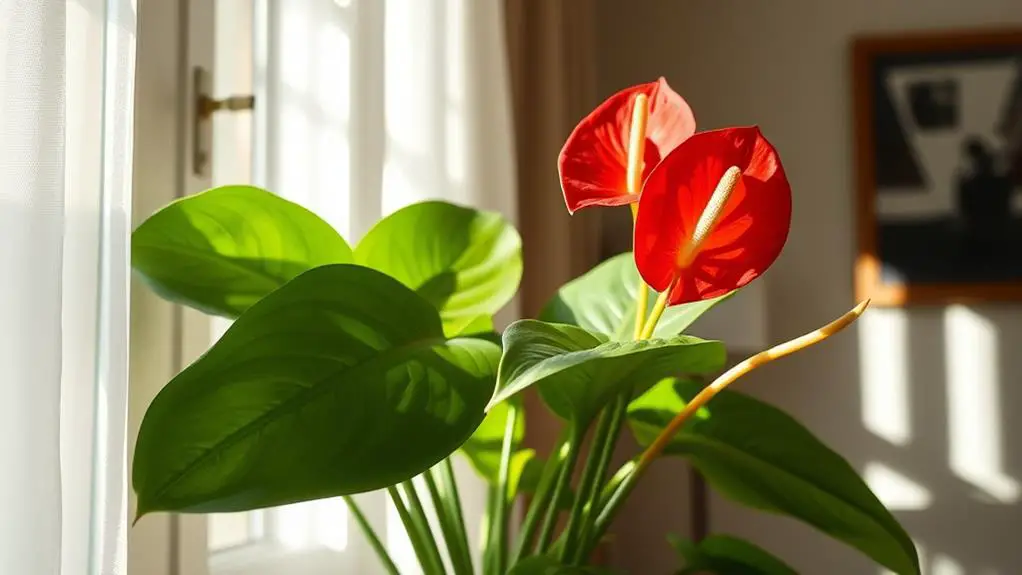
To keep your anthurium happy, place it near an east or west-facing window where it gets bright, indirect light.
Direct sunlight can harm the leaves and flowers, so make sure it's shielded from harsh rays.
If your space lacks natural light, don't hesitate to use grow lights to keep your plant thriving.
Bright Indirect Light
When setting up the perfect environment for your Anthurium, guaranteeing it gets bright, indirect light is essential. This type of light mimics the filtered sunlight under tropical forest canopies, helping your plant thrive.
Placing your Anthurium near east or west-facing windows provides the ideal light conditions for vibrant flowers and healthy growth. If the plant gets insufficient light, it may stretch toward light sources, leading to elongated leaves and fewer flowers.
On the other hand, too much direct sunlight can cause leaf burn and damage. Keep an eye on light levels to guarantee your Anthurium stays vibrant and healthy.
With bright, indirect light, your plant will reward you with beautiful blooms and lush foliage.
Avoid Direct Sunlight
Direct sunlight can be harsh for your Anthurium, causing leaf damage and flower discoloration.
Anthuriums prefer bright, indirect light to thrive and display their brightly colored flowers. Too much direct sunlight can turn these vibrant flowers green and harm the leaves.
To avoid this, place your Anthurium where it gets a good amount of light without being directly exposed to the sun. East or west-facing windows often provide the perfect filtered light.
Regularly monitor your plant for signs of stress like yellowing leaves or green flowers. This helps you adjust its light exposure accordingly.
Optimal Window Placement**
Finding the perfect window placement for your Anthurium is essential for its health and vibrant blooms.
Place your Anthurium near east or west-facing windows to provide bright, indirect light. This setup mimics the medium light conditions of tropical forests, which is ideal for your plant.
Avoid direct sunlight exposure to prevent leaf burning and flowers turning green too soon. Regularly monitor your plant's response to its light conditions.
If you notice any yellow leaf, it might be getting too much sunlight. On the other hand, if the leaves elongate and flowering decreases, it needs more light.
Adjust its placement accordingly, and your Anthurium will thrive, producing beautiful blooms to brighten your space.
Watering Techniques
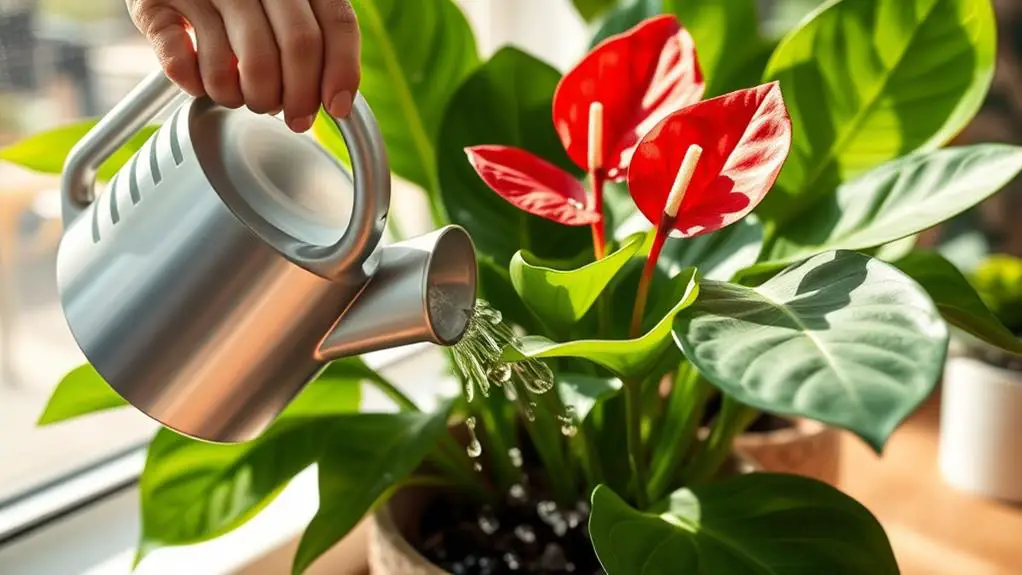
When it comes to watering your Anthurium, keeping the right moisture level is essential.
Water every 1-2 weeks and let the top two inches of soil dry out to avoid overwatering.
Make sure you use a well-draining pot and lukewarm water to keep your plant healthy and happy.
Proper Moisture Levels
Maintaining proper moisture levels is essential for the health of your Anthurium. Water your plant every 1-2 weeks, allowing the top two inches of soil to dry out between waterings. This helps prevent root rot, which can occur if the soil stays too wet.
Use pots with adequate drainage holes to guarantee excess water can escape. Overwatering can cause yellow leaves, a sign that the plant is getting too much water or lacks proper drainage.
In brighter light, you'll need to water more often, but reduce the frequency in lower light conditions. During winter months, your Anthurium's growth slows down, so you should water less frequently.
This balance keeps your plant thriving year-round.
Avoid Overwatering Risks
Overwatering is one of the most common pitfalls when caring for Anthuriums. To keep your plant healthy, follow these care tips.
First, verify the top two inches of soil are dry before watering. This prevents root rot, a major issue for Anthuriums.
Second, water your plant every 1-2 weeks, adjusting based on light conditions. Brighter light may need more frequent watering, while lower light needs less.
Third, use pots with ample drainage holes to let excess water escape.
- Check soil: Make sure the top two inches are dry.
- Watering schedule: Adapt based on light.
- Drainage: Use pots with drainage holes.
Soil Drainage Importance
Understanding the importance of proper soil drainage can make all the difference in maintaining a healthy Anthurium plant. Proper soil drainage prevents root rot, a common issue caused by water accumulation.
To achieve this, use a well-draining soil mix made from equal parts peat moss, perlite, and orchid bark. This mix guarantees excess water escapes easily and air circulates around the roots. Make sure your pots have ample drainage holes at the bottom.
Water your Anthurium when the top two inches of soil feel dry to the touch, allowing the soil to dry out between waterings. Regularly monitor moisture levels and adjust your watering routine based on environmental conditions.
This way, your plant stays happy and healthy.
Soil and Fertilization

For thriving Anthuriums, the right soil mix is vital. You'll want to use equal parts peat moss, perlite, and coarse sand or orchid bark. This combination guarantees proper drainage and aeration, which are essential for healthy roots.
When it comes to fertilization, use a balanced, water-soluble fertilizer. Apply it monthly during the growing season and reduce frequency in fall and winter.
Here are some tips:
- Use a gentle nutrient mix, like a 10-4-3 fertilizer, to promote healthy foliage and blooms.
- Avoid over-fertilization to prevent root burn and brown spots on leaves.
- Check soil moisture levels regularly and adjust your watering schedule as needed.
Maintain Humidity Levels

Maintaining the right humidity levels is just as important as choosing the proper soil and fertilization for your Anthurium.
These tropical plants thrive in humidity levels around 80%, so it's essential to create a humid environment. Dry air, especially in winter, can cause brown leaf tips and stress.
To counter this, use a humidifier or place a wet pebble tray under the plant to boost humidity levels. Regular misting can also help, but be careful not to wet the crown to avoid rot.
Monitoring humidity with a hygrometer guarantees the plant stays healthy. By maintaining the right humidity levels, you'll keep your Anthurium vibrant and thriving.
Repotting Guidelines
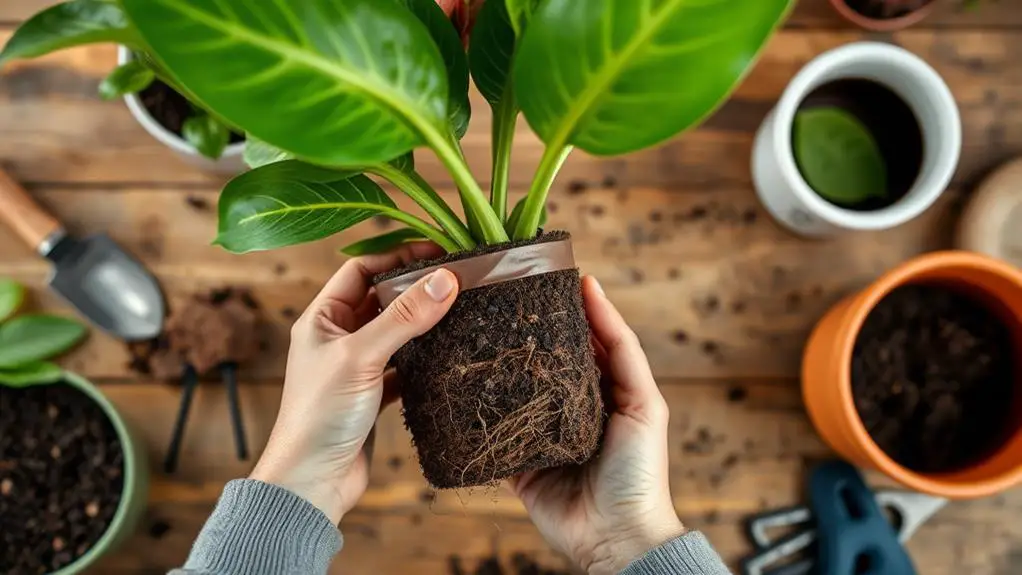
When it comes to repotting your Anthurium, you'll want to make certain it's done every 2-4 years or when you see root crowding in the pot.
Choose a well-draining soil mix composed of equal parts peat moss, perlite, and coarse sand or orchid bark. It's best to repot during the spring or summer, aligning with the plant's active growth period for minimal stress.
Follow these steps:
- Gently remove the plant from its old pot, trimming any dead or damaged roots.
- Place the Anthurium in a new container with ample drainage holes to prevent water accumulation.
- Fill with fresh, well-draining soil to promote healthy root development.
Repotting helps keep your Anthurium thriving and happy!
Monitor for Pests and Issues

After repotting your Anthurium, keeping an eye out for potential pests and issues is essential to maintaining its health.
Regularly monitor for common pests like spider mites, aphids, and mealybugs. Look for signs such as webbing, sticky residue, or visible bugs on the leaves and stems.
Early intervention is vital; treat infestations with insecticidal soap or neem oil before they worsen.
Monitor the humidity levels, as dry air can make pest problems worse. Aim for humidity above 50-60% to help deter pests.
Clean the leaves monthly to remove dust and debris, which can harbor pests and hinder growth.
Frequently Asked Questions
How Do You Care for a Potted Anthurium?
Place your potted Anthurium in bright, indirect light. Water every 1-2 weeks, let the topsoil dry out. Maintain 80% humidity, keep temperatures between 65°F-75°F, and fertilize monthly during spring and summer with diluted nitrogen-rich fertilizer.
How Do You Keep Anthuriums Blooming?
To keep your Anthuriums blooming, provide bright, indirect light, maintain high humidity, water consistently, and feed with diluted nitrogen-rich fertilizer monthly during the growing season. Regularly prune spent flowers to encourage new growth and continuous blooming.
How Often Should I Water My Anthurium?
Water your Anthurium every 1-2 weeks, letting the top two inches of soil dry out between waterings. Increase frequency in brighter light, decrease in lower light. Always check soil moisture first to prevent overwatering and root rot.
How Do You Make Anthurium Thrive?
To make your Anthurium thrive, give it bright, indirect sunlight and high humidity. Water it every 1-2 weeks, letting the top soil dry out. Maintain temperatures between 65°F-75°F and fertilize monthly during the growing season.
Conclusion
Growing an Anthurium plant isn't hard if you follow these seven steps. Give it the right light, water it correctly, use good soil, and fertilize it during the growing season. Keep the humidity high, repot when necessary, and watch for pests. By doing this, you'll help your Anthurium stay healthy and beautiful. Remember, every plant is different, so be patient and enjoy the process. You've got this, and your Anthurium will thrive!

